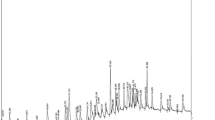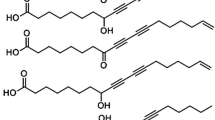Abstract
The fatty acid composition, tocopherol and tocotrienol content, and oxidative stability of petroleum benzene-extracted Gevuina avellana Mol (Proteaceae) seed oil were determined. Positional isomers of monounsaturated fatty acids were elucidated by gas chromatography-electron impact mass spectrometry after 2-alkenyl-4,4-dimethyloxazoline derivatization. This stable oil (Rancimat induction period at 110°C: 20 h) is composed of more than 85% monounsaturated fatty acids and about equal amounts (6%) of saturated and polyunsaturated (principally linoleic) fatty acids. Unusual positional isomers of monounsaturated fatty acids, i.e., C16:1 Δ11, C18:1 Δ12, C20:1 Δ11, C20:1 Δ15, C22:1 Δ17, and presumably C22:1 Δ19 were identified. The C18:1 Δ12 and C22:1 Δ19 fatty acids are described for the first time in G. avellana seed oil. While only minute quantities of α-, γ-tocopherols and β-, γ- and δ-tocotrienols were found, the oil contained a substantial amount of α-tocotrienol (130 mg/kg). The potential nutritional value of G. avellana seed oil is discussed on the basis of its composition.
Similar content being viewed by others
References
Halloy, S., A. Grau, and B. McKenzie, Gevuina Nut (G. avellana, Proteaceae), a Cool Climate Alternative to Macadamia, Econ. Bot. 50:224–235 (1996).
Vickery, J.R., The Fatty Acid Composition of the Seed Oils of Proteaceae: A Chemotaxonomic Study, Phytochemistry 10:123–130 (1971).
Malec, L.S., M.S. Vigo, and P. Cattáneo, Semilla de G. avellana Mol (Proteaceae). Composición Química del Aceite Crudo de Extracción y de la Harina Residual, An. Asoc. Quím. Argent. 74:311–320 (1986).
Cattáneo, P., G.K. de Sutton, R.H. Arias, R.R. Brenner, and M.E. de Tomas, Aceites de Semilla de Proteáceas Argentinas. Composición Química de los Aceites de G. avellana Mol, Lomatia hirsuta (Lam) Diels y Embothrium coccineum Forst, Ibid.:31–57 (1962).
Mella, R.M.A., and S.L. Masson, Materias Grasas Vegetales de Consumo Habitual y Potencial en Chile, Grasas Aceites (Sevilla) 35:240–245 (1984).
Gunstone, F.D., R.J. Hamilton, F.B. Padley, and M.I. Qureshi, Glycerides Studies. The Distribution of Unsaturated Acyl Groups in Vegetable Triglycerides, J. Am. Oil Chem. Soc. 42:965–970 (1965).
Determinazione della sostanza grassa, metodo NGD A4 (1976) (Norme italiane per il controllo dei Grassi e Derivati), from SSOG (Stazione Sperimentale per le Industrie degli Oli e dei Grassi, Milano, Italy).
Fay, L.B., and U. Richli, Location of Double Bonds in Polyunsaturated Fatty Acids by Dimethyloxazoline Derivatization, J. Chromatogr. 541:89–98 (1991).
Oil Stability Index, in Official Methods and Recommended Practices of the American Oil Chemists’ Society, 4th edn., AOCS Press, Champaign, 1993, Method Cd 12b-92.
Zhang, J.Y., Q.T. Yu, B.N. Liu, and Z.H. Huang, Chemical Modification in Mass Spectrometry IV. 2-Alkenyl-4,4-dimethyloxazolines as Derivatives for the Double Bond Location of Long-Chain Olefinic Acids, Biomed. Environ. Mass Spectrom. 15:33–44 (1988).
Madhavi, D.L., R.S. Singhal, and P.R. Kulkarni, Technological Aspects of Food Antioxidants, in Food Antioxidants. Technological, Toxicological, and Health Perspectives, edited by D.L. Madhavi, S.S. Deshpande, and D.K. Salunkhe, Marcel Dekker, New York, 1996, pp. 159–265.
Ivanov, St. A., and K. Aitzetmüller, Untersuchungen über die Tocopherol- und Tocotrienolzusammensetzung der Samenöle einiger Vertreter der Familie Apiacae, Fat Sci. Technol. 97:24–29 (1995).
Ashwell, M., Diet and Heart Disease, 2nd ed., British Nutrition Foundation, Chapman & Hall, London, 1997, pp. 56–60.
Cáceres, J.O., R.G. Anrique, A.S. Voullieme, and C.S. Méndez, Utilización del Fruto del Avellano (Gevuina avellana Mol.) en Alimentación de Pollas Cornish de 0 a 30 Días de Edad. Simientes 52:161 (1982).
Pohl, P., and H. Wagner, Fettsäuren im Pflanzen- und Tierreich (eine Übersicht) I: Gesättigte und cis-ungesättigte Fettsäuren, Fette Seifen Anstrichm. 74:424–435 (1972).
Plattner, R.D., and R. Kleiman, Grevillea robusta Seed Oil: A Source of ω-5 Monoenes, Phytochemistry 16:255–256 (1977).
Weber, N., K. Vosmann, L. Brühl, and K.D. Mukherjee, Metabolism of Dietary Petroselenic Acid: A Dead-End Metabolite of Desaturation/Chain Elongation Reactions, Nutr. Res. 17:89–97 (1997).
Author information
Authors and Affiliations
Corresponding author
About this article
Cite this article
Bertoli, C., Fay, L.B., Stancanelli, M. et al. Characterization of chilean hazelnut (Gevuina avellana mol) seed oil. J Am Oil Chem Soc 75, 1037–1040 (1998). https://doi.org/10.1007/s11746-998-0283-5
Received:
Accepted:
Issue Date:
DOI: https://doi.org/10.1007/s11746-998-0283-5




